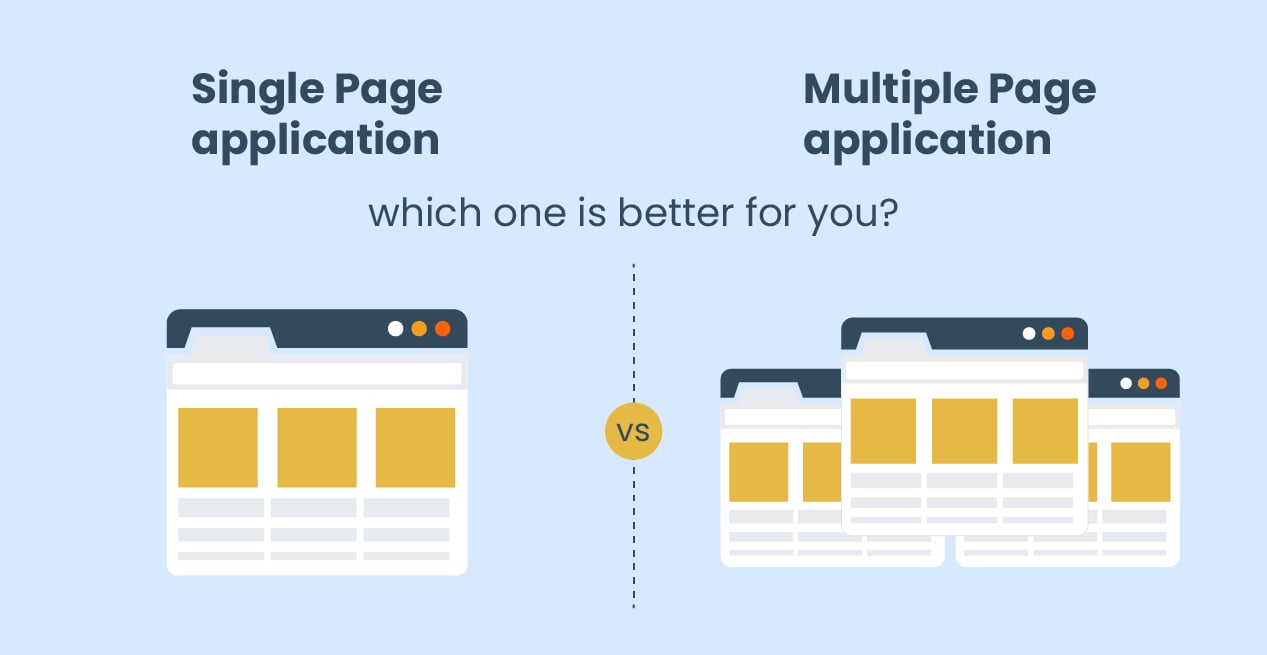Embark on a journey with us as we delve into the nuances of SPA vs MPA, breaking down their features to assist you in making well-informed decisions for your web endeavors. Let the comparison commence!
What are Web Applications?
A web application is software that runs in your web browser and delivers services remotely. Businesses employ web applications to connect with customers conveniently and securely. Such applications help access complex functionality without installing or configuring software.
People often get confused between web applications and normal websites. Web applications employ server-side scripts and client-side scripts to present information and use servers to manage requests from the user.
A website, on the other hand, is a compilation of single or multiple web pages. Websites are also different as they need not be precompiled before deployment and can be accessed without inbuilt authentication systems. Given are the characteristic features of web applications:
- They do not need to be downloaded.
- Most web applications are multi-platform friendly, i.e. they can run on operating systems like Windows, macOS, and Linux as long as the browser is compatible.
- Web applications mostly use server-side and client-side.
Some examples of commonly used applications are Flipkart, Twitter, Amazon, etc. To understand web applications better let us have a look at the two most popular types of web applications.
- Single Page Applications or SPAs
- Multi-Page Applications or MPAs
Single-page applications or SPAs
A Single Page Application, also known as SPA, is a type of web application that allows users to work on HTML pages. A SPA extracts all of the code be it HTML, JavaScript, or CSS code on the initial load and loads resources dynamically.
SPAs employ HTML5 and Ajax( Asynchronous JavaScript and XML) to draft smooth and best responses to user requests. Ajax technology also helps instant updation of content after an action is performed. It does so after a page is loaded and data is returned in Java format thus eliminating the need for constant reloading.
As SPAs use Javascript and HTML components for their front ends while a different platform handles their back end. Navigation applications, many social media platforms, and email providers are the most common examples of single-page applications.
Advantages of SPAs
Single-page applications come with a host of benefits:
- Seamless user experience
- Faster performance and delivery
- Reduced server load
- Smooth navigation throughout the page
- Easier maintenance because of the modular structure of its component
- Caching and offline support
- Responsive and versatile design
- Rich, interactive user interfaces
- Support for cross-platform development
While single-page applications offer a variety of benefits, they also come with their own set of challenges such as:
- Longer initial load time compared to traditional multi-page applications
- Lower Search Engine Optimization (SEO) ranking
- More complex than traditional applications
- More vulnerable to Cross-Site Scripting attacks
- Dependency on JavaScript can be a hindrance to quality output
These challenges can be addressed through the implementation of better development practices. They should be weighed against its long list of benefits for a comprehensive understanding of what is the best fit for your project.
A Typical SPA lifecycle
Multi-page Applications or MPA
As the name suggests, a multi-page application or MPA is made up of numerous web pages. Unlike single-page applications, an MPA comprises multiple HTML pages, each a separate document. Also, in an MPA, when a user clicks on a link or enters a URL, an HTML page is loaded which often results in a full page refresh.
Multi-page applications can easily be differentiated from other web applications for their character features such as full page reloads, server-side rendering, and multiple HTML pages amongst others. eBay and Amazon are two examples of Multiple Page Applications that are very popular amongst the masses. These websites transfer a lot of data from server to client and vice versa hence they are low on speed.
Advantages of MPAs
MPAs can be goto web applications for enterprises for the following reasons:
- Better SEO of MVPs as search engines can easily crawl and index the content.
- MPAs are typically easier and simpler to understand and develop.
- Faster initial load times compared to some single-page applications (SPAs) since only the necessary resources for the current page are loaded.
- Clear separation between server-side and client-side logic.
- Debugging is often straightforward in MPAs.
- Less complex development
A typical MPA lifecycle
Challenges of MPAs
- Full page reloads MPAs typically result in slower user interactions
- Full page reloads mean more requests to the server, potentially increasing the server load.
- Limited interactivity MPAs might offer limited interactivity compared to SPAs.
- Complexity in code maintenance
- SEO Challenges for Dynamic Content and Search Engine Crawlers
- Limited offline capabilities
It’s important to note that a business must choose between Multi-Page Applications and single-page applications depending on the specific requirements and goals of a project. While MPAs have many advantages, SPAs should be preferred in situations where a more dynamic and interactive user experience is a priority.
SPA vs MPA: Key Differences To Know
Here are some factors that can help us differentiate between single and multiple-page applications.
Security:
While SPAs are more susceptible to criminal attacks, MPAs deliver a higher level of security by reloading pages every time.
Speed:
Speed is a noticeable difference between the two types of web applications. Since SPA has the benefit of being preloaded it has speed. It does however experience a lag initially before deployment. MPA on the other hand deals with huge volumes of data and requests data from each page resulting in slower output times.
Time Taken to Develop:
SPAs’ front and back ends are isolated from one another, allowing them to be created concurrently, which speeds up development time. On the other hand, since MPAs are a little bit more sophisticated, they often take longer to mature.
Developers of MPA must employ frameworks for either the client-side or server-side, which increases development time.
SEO Friendliness
A SPA lacks SEO friendliness. Unfortunately, that means that they have reduced visibility compared to MPAs. One of the reasons for this lack of SEO features is that single-page applications use JavaScript, which very few search engines support.
On the contrary, MPA allows SEO of each page for a separate keyword, improving website reach and ranking. MPAs also allow meta tags to be added to any page which further improves a site’s ranking.
User Experience
Since a sizable percentage of traffic comes from mobile devices, it can easily be concluded that SPA is more mobile-friendly. Even Google, the tech giant has started preferring mobile devices over desktop ones and is investing in SPA frameworks to create mobile applications.
The MPA, on the other hand, enables improved information architecture. One has no restrictions on how many pages you can build or how much content you can fit on a single page. Simple navigation improves user experience by making it simple for visitors to traverse the website.
Development and Maintenance
Developing SPAs typically entails a more intricate process, yet it can result in simplified maintenance and updates.
MPA involves a simpler initial development phase, but making updates might necessitate modifications across multiple pages.
Navigation:
SPAs navigate seamlessly without the need for full-page reloads, contributing to an enhanced user experience.
MPA depends on conventional page-to-page navigation.
URL Structure:
SPAs commonly employ hash fragments or client-side routing to alter URLs without resorting to full reloads.
MPA showcases a distinct hierarchy in the URL structure, assigning a unique URL to each page.
MPA vs SPA: What to Choose?
Choosing between SPA and MPA depends on the project’s requirements, user experience goals, and development preferences, still, certain criteria ease out the choice.
- Choose SPA if you focus on fast-loading and have a complex application.
- Choose MPA if your focus is more on SEO
- Security concerns? opt for MPA as it offers more security.
- Time to market? SPA’s are easy and faster to build, thus less time to launch and market the products.
SPA vs MPA: The Conclusion
MPA and SPA are both reliable web applications. However, if an enterprise is looking to invest in the same, they should do so after carefully examining what their requirements are.
Once those have been established they should start looking for a custom web development company like OpenXcell to materialize their vision into actual web apps.
OpenXcell has a rich roster of successful clients and products which it leverages to deliver quality software solutions. Surely a company to consider unique web app solutions and web app architecture.








